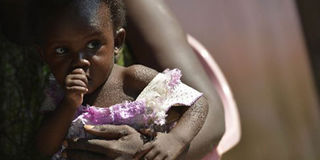Helping children to thrive at their home settings

A baby at the "ONO" orphanage in the Mali-Maka district in the 5th arrondissement of Bangui on January 6, 2014. Institutions have long been linked with adverse effects on children well into adulthood, and are being phased out in many parts of the world. PHOTO | FILE
What you need to know:
Although they have the best intentions, institutions make for a poor substitute for parental love and affection.
Institutions have long been linked with adverse effects on children well into adulthood, and are being phased out in many parts of the world.
The Christmas holidays came just a few short weeks ago and, with it, the spirit of giving. As observed from many social media sites, many people reached out to the less privileged, in different ways some of which were really innovative, such as placing orders on Amazon, for deliveries to homeless people in the US. Closer home in Kenya, corporates and individuals made what has now become the traditional annual visit to charitable children’s institutions (CCIs), or if you like, children’s homes. It was all genuinely moving and a real representation of the kindness of humanity.
POVERTY
While giving to CCIs is a noble gesture, we must try and nip in the bud the underlying causes for children ending up there in the first place. Lumos Foundation estimates that only 20 per cent of children in orphanages are actually orphans. This means that an astounding 80 per cent of children in those institutions have at least one living parent.
Poverty remains the biggest reason for the separation of children from their parents. Although they have the best intentions, institutions make for a poor substitute for parental love and affection. Institutions have long been linked with adverse effects on children well into adulthood, and are being phased out in many parts of the world.
As the country moves towards winding down institutionalisation, here is another way you can still help children thrive, but this time, in their home settings. Consider seeking out needy families within you community and give directly to parents or primary caregivers of children. I found that there are some valuable resources which, if used judiciously, can help one select whom to assist, if their interest is to make a difference in the lives of children and families.
CHILDREN OFFICERS
These fall under the Ministry of Labour and Social Protection. Social protection is not a devolved function, but there is a children’s office in each sub-county. Often times, caregivers who are at their wits end up in these offices seeking whatever form of assistance they can get for the survival of their children.
Many of these children’s offices maintain a waitlist of vulnerable households. Children’s officers can play a pivotal role in identifying a family (or several) to support since they interact with caregivers from needy families almost on a daily basis.
Volunteer community workers
Volunteers at the community level could be Community Health Volunteers (CHVs), Volunteer Children’s Officers (VCOs), or any other volunteers working closely with the community. These are champions in identifying needy households with children, and will take you right to their doorstep, or mobilise for you as many disadvantaged households as you can possibly take into one place, if you so wish.
LOCAL CHIEFS
You will find that many chiefs and assistant chiefs are well versed with the community to the extent that they know most members by name. They are heavily involved in activities meant to promote the welfare of the community. They can easily point out to you which ailing grandmother is taking care of nine grandchildren alone because her own children are all deceased, or which academically gifted child has failed to join secondary school for lack of school fees.
In Kenya, teachers in public primary schools come across children from all manner of backgrounds, majority of whom are poor.
The writer is researcher – social and economic development.




